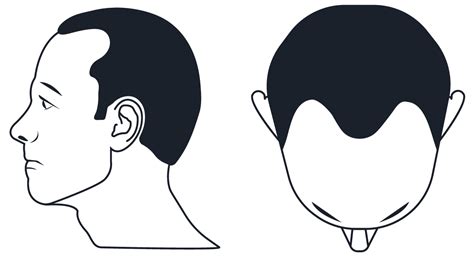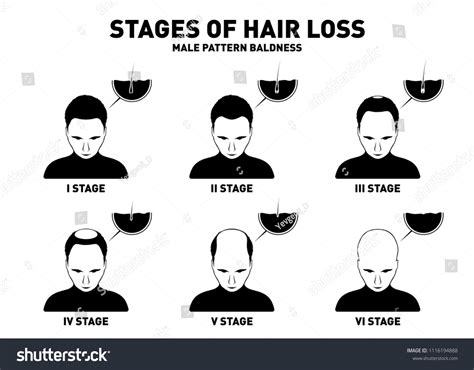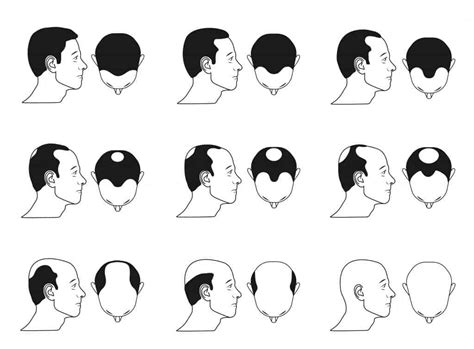Understanding Male Pattern Baldness (Androgenetic Alopecia)
Male pattern baldness, clinically known as androgenetic alopecia, is the most common form of hair loss in men. It’s a genetic condition influenced by hormones, particularly dihydrotestosterone (DHT), which causes hair follicles to shrink over time, eventually leading to thinner, shorter hairs and ultimately, complete cessation of hair growth. The progression of this condition is often gradual and predictable, following a set of stages that have been formally classified.
To accurately describe and categorize the various patterns of hair loss, medical professionals commonly use the Norwood-Hamilton Scale. Developed by Dr. James Hamilton in the 1950s and later updated by Dr. O’Tar Norwood in the 1970s, this scale provides a visual guide to the different stages of male pattern baldness, ranging from minimal hair loss to extensive balding. Understanding these stages can help individuals identify their level of hair loss and explore appropriate management or treatment options.

The Norwood-Hamilton Scale: A Closer Look at Hair Loss Stages
The Norwood-Hamilton Scale divides male pattern baldness into seven main types, with some sub-classifications, offering a detailed roadmap of how hair loss typically evolves.
Stage 1: Minimal or No Hair Loss
At this initial stage, there is no significant hair loss or recession of the hairline. The hairline is typically full and youthful, with no noticeable balding in the crown or temple areas. Hair is generally dense and healthy across the scalp.
Stage 2: Early Stages of Recession (Mature Hairline)
This stage is characterized by a slight recession of the hairline around the temples. It often forms a ‘V’ shape, known as a mature hairline, which is generally not considered balding but rather a natural progression from a juvenile hairline. While subtle, it is the first indication of a receding hairline. Hair density remains good elsewhere.

Stage 3: Visible Hair Loss and Crown Thinning
Stage 3 marks the beginning of significant hair loss that is considered clinically baldness. The recession at the temples becomes more pronounced, often forming an ‘M’, ‘U’, or ‘V’ shape, with sparse or no hair in the recessed areas. A common variation at this stage is Stage 3 Vertex, where the hairline recession is less severe, but there is significant hair loss or thinning on the crown (vertex) of the scalp.
Stage 4: Distinct Bald Areas
At Stage 4, the recession at the temples is more severe than in Stage 3, and a prominent bald area on the crown is clearly established. These two bald areas (frontal-temporal and crown) are still separated by a band of hair that extends across the top of the scalp, though this band of hair may be thinning.

Stage 5: Further Enlargement and Thinning
Stage 5 shows greater hair loss than Stage 4. The bald areas at the temples and crown become larger, and the band of hair separating them becomes narrower and thinner. The distinction between the frontal and crown bald areas is still visible but increasingly less defined.
Stage 6: Merging Bald Areas
By Stage 6, the bridge of hair that once separated the frontal and crown bald areas has largely disappeared or is very sparse. The two areas of baldness merge into a single, large area of hair loss. The total area of balding is significantly larger, and the remaining hair on the sides and back may also start to thin.

Stage 7: Most Severe Hair Loss
This is the most advanced stage of male pattern baldness. Only a narrow band of hair remains, extending around the sides and back of the scalp in a horseshoe shape. This remaining hair is usually thinner and less dense than normal. The top and crown of the head are almost completely bald.
Understanding and Addressing Male Pattern Baldness
It’s important to remember that not every man will progress through all seven stages, and the rate of hair loss varies greatly among individuals. Some men may stabilize at an earlier stage, while others may experience rapid progression. Factors like genetics, age, and hormone sensitivity all play a role in how male pattern baldness manifests and advances.
If you are experiencing hair loss and are concerned about its progression, consulting with a dermatologist or a hair loss specialist can provide clarity. They can accurately assess your stage of baldness, discuss potential underlying causes, and recommend various treatment options, which may include topical solutions, oral medications, or surgical interventions like hair transplantation, depending on your individual needs and stage of hair loss.

Conclusion
The Norwood-Hamilton Scale provides an invaluable framework for understanding the typical stages of male pattern baldness. From the subtle hairline recession of Stage 2 to the extensive baldness of Stage 7, recognizing these stages can empower individuals to seek timely advice and explore effective strategies for managing their hair loss journey.




